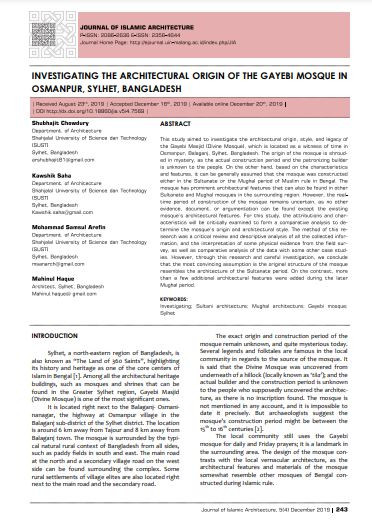
This study aimed to investigate the architectural origin, style, and legacy of the Gayebi Masjid (Divine Mosque), which is located as a witness of time in Osmanpur, Balaganj, Sylhet, Bangladesh. The origin of the mosque is shrouded in mystery, as the actual construction period and the patronizing builder is unknown to the people. On the other hand, based on the characteristics and features, it can be generally assumed that the mosque was constructed either in the Sultanate or the Mughal period of Muslim rule in Bengal. The mosque has prominent architectural features that can also be found in other Sultanate and Mughal mosques in the surrounding region. However, the real-time period of construction of the mosque remains uncertain, as no other evidence, document, or argumentation can be found except the existing mosque’s architectural features. For this study, the attributions and characteristics will be critically examined to form a comparative analysis to determine the mosque’s origin and architectural style. The method of this research was a critical review and descriptive analysis of all the collected information, and the interpretation of some physical evidence from the field survey, as well as comparative analysis of the data with some other case studies. However, through this research and careful investigation, we conclude that the most convincing assumption is the original structure of the mosque resembles the architecture of the Sultanate period. On the contrast, more than a few additional architectural features were added during the later Mughal period.
I agree to the terms outlined below:
You agree to upload and assign Mosqpedia Database the rights to use the content worldwide and in perpetuity across all current and future media platforms. Mosqpedia Database may edit, copy, adapt and translate your contribution.
The content will be distributed under the Creative Commons Attribution-Deed – Attribution-NonCommercial-NoDerivatives 4.0 International – Creative Commons
All data will be stored in line with data protection regulations.